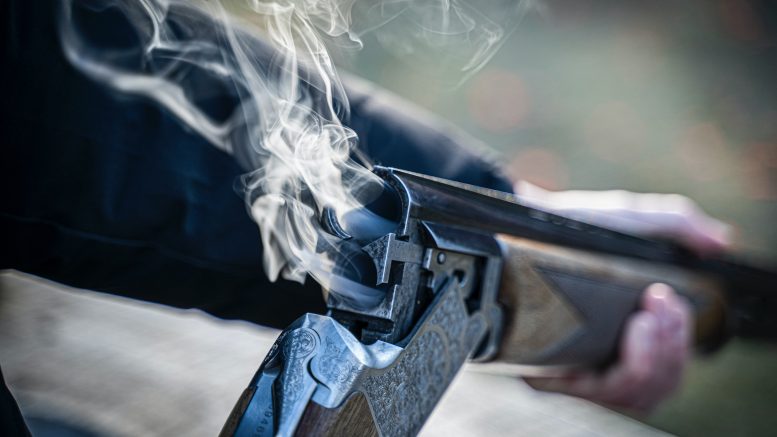A man veers his SUV onto a sidewalk, accelerating straight at a group of pedestrians as he screams, “I’m going to kill you!” He misses his targets and is arrested within minutes. Police soon learn the suspect’s father recently contacted them, worried that his son was “delusional and paranoid.”
The father also had another piece of information: His son had an arsenal of 10 handguns, three AR-15 rifles and a shotgun. The officers decided that regardless of what happened with their attempted assault case against the suspect, he was a prime candidate for a Gun Violence Restraining Order, also known as an “extreme risk” or “red flag” order.
That was one of 21 cases analyzed by the UC Davis School of Medicine as part of a new study suggesting that California’s landmark red flag law has prevented numerous mass shootings, similar to ones that struck Gilroy, El Paso and Dayton over the course of seven days in late July and early August, claiming 34 lives and injuring scores of others.
In Sacramento County, nine “red flag” orders were granted between 2016 and 2017, when the study was conducted.
Now, the victims’ advocate who was key in getting the law passed is working to get it adopted at the federal level. And even with President Donald Trump backsliding on his commitment to confronting gun violence, some politicians on both sides of the aisle say gun violence restraining orders may stand a chance of passing on Capitol Hill this year.
Preempting gun violence became a crusade for Amanda and Nick Wilcox after their daughter Laura’s death in a mass shooting in 2001. The 19-year-old sophomore at Haverford University in Pennsylvania had come home to Penn Valley on her winter break and started working at the Nevada County Behavioral Health Clinic. That’s where a disturbed 40-year-old patient opened fire, killing Laura and two others and wounding three more people.
“His family, his girlfriend and his case worker were all worried about him, but they had no way of legally taking way his weapon,” Amanda Wilcox told SN&R.
While she was still in shock, her husband, a scientist, threw himself into research. He discovered that Connecticut had a law that allowed for the seizure of firearms when a person’s loved ones—or law enforcement—believed they were highly dangerous.
In 2013, the Wilcoxes had a meeting with then-Assemblywoman Nancy Skinner, a Berkeley Democrat. Also present were advocates for the mental health and disabilities communities. Looking back, Amanda Wilcox said it was critically important to have those voices in the conversation, so the resulting legislation wouldn’t broadly target Californians with mental health challenges.
Nevertheless, when Skinner first proposed her red flag law in 2014, it looked like it might be dead on arrival. Influential Democrats were lining up against it.
“There was tremendous push back,” Amanda Wilcox recalled. “There was so much concern it was rife for abuse by neighbors, and that there wasn’t due process.”
During her emotional testimony in front of the Senate Public Safety Committee, Amanda Wilcox ended her remembrance of Laura by saying, “You can always get a gun back; you can’t get a life back.”
Ultimately, by convincing members of the legislature that the law would provide tools to deal with anyone experiencing extreme emotional crisis, a heightened state of anger, the onset of dementia or constant thoughts of suicide, Skinner’s team got California’s red flag law over the finish line. It went into effect in 2016.
The UC Davis study examines its first two years of implementation.
Of the 21 cases it cites as potentially having stopped a mass shooting, seven involved a disgruntled employee threatening workplace violence; three involved current or former high school students threatening campus violence; two involved suspicions about religiously motivated terror; and one involved a veteran with Post-Traumatic Stress Disorder.
The authors of the study are careful to point out that they can make “no causal claim” as to what would have happened if the orders had not been issued.
Two weeks ago, an APM Research Lab poll found three-fourths of Americans support family-initiated “red flag” laws, and 70% support those initiated by law enforcement. Fifteen states already have some version of a “red flag” law.
On March 26, the Senate Judiciary Committee examined whether Congress should provide financial incentives to states for developing “red flag” laws. A witness who cautioned against the laws was Dave Kopel, research director for the Independence Institute, a libertarian think tank based in Denver.
“Federal funding should reward states only for best practices which protect civil rights and public safety,” Kopel said, adding that some states require very little burden of proof for a seizure. “The period when someone is disarmed is the period when they’re vulnerable, and without due process protections these laws can be abused by stalkers and other domestic abusers who want to temporary disarm their intended victims.”
Sen. Dick Durbin, an Illinois Democrat, pushed back, pointing out that most domestic violence victims’ advocacy groups support “red flag” laws.
The hearing ended with Sen. Lindsey Graham, a South Carolina Republican, saying, “I really can’t see a reason why we can’t pursue this at the federal level.”
Amanda Wilcox, who testified at the hearing, was encouraged by the words from Graham and other Republicans. Despite a series of conflicting statements from Trump on gun laws in recent days, Wilcox and other advocates are convinced “red flag” legislation could get through Congress this year.
As for the UC Davis study’s findings, Wilcox choked up a little, saying, “We’re really saving lives, and that’s the best way I know to honor my daughter.”


Be the first to comment on "Red flag of courage: Researchers identified 21 potential shootings curbed by family members or law enforcement in just two years"